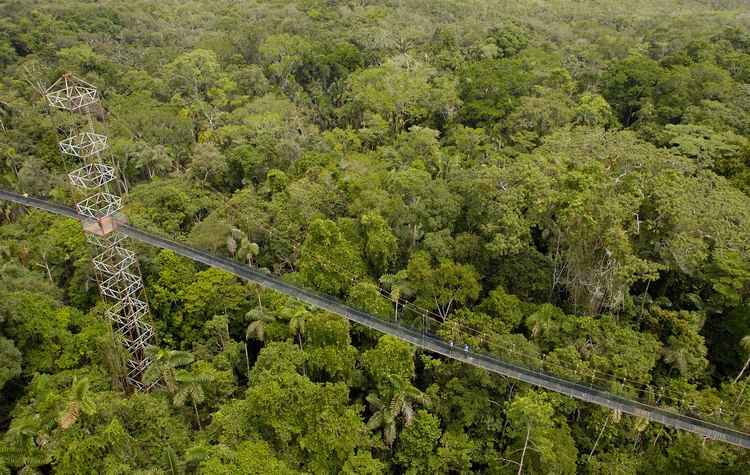
Travel to the Amazon Rainforest, often referred to as the “Lungs of the Earth,” is a vast and ecologically critical expanse of biodiversity. For tourists eager to experience its wonders, there are numerous opportunities to contribute to wildlife protection and conservation efforts.
Responsible tourism in the Amazon involves making informed choices about where to visit, how to minimize environmental impact, and actively participating in initiatives that safeguard the delicate ecosystems and diverse wildlife. Visiting the mighty Amazon doesn’t have to be detrimental to the wildlife of the region, in fact – tourism can play a vital role in preserving the Amazon Rainforest while visitors also enjoy an unforgettable adventure.
1. Yasuní National Park, Ecuador: A Model for Sustainable Tourism
Yasuní National Park, situated in the Ecuadorian Amazon, is renowned for its unparalleled biodiversity. It is home to various indigenous communities, rare species like the pink river dolphin, and iconic Amazonian wildlife.
The park faces threats from oil extraction, deforestation, and illegal wildlife trade. Sustainable tourism initiatives, such as those supported by the Yasuní Foundation, aim to raise awareness, protect the park, and support indigenous communities.
Tourists can participate in guided tours led by knowledgeable local guides, contributing to community-based conservation projects. Support eco-friendly lodges like the Napo Wildlife Center, which actively engages in wildlife protection and environmental education.
2. Manu National Park, Peru: A UNESCO World Heritage Site

Manu National Park is one of the world’s most biodiverse areas, boasting an incredible array of flora and fauna. It spans from Andean highlands to lowland rainforests, providing diverse ecosystems.
Recognized as a UNESCO World Heritage site, Manu faces threats from illegal logging and habitat destruction. Conservation organizations like Rainforest Partnership work with local communities to protect the park and promote sustainable alternatives.
Choose eco-friendly lodges, such as Manu Learning Centre, known for their commitment to sustainability. Participate in wildlife monitoring programs and educational initiatives that directly contribute to the preservation of the park’s unique ecosystems.
3. Tambopata National Reserve, Peru: Balancing Adventure and Conservation

Tambopata National Reserve is famed for its diverse wildlife, including macaws, jaguars, and giant river otters. The reserve is a critical part of the Madre de Dios watershed.
Threats to Tambopata include illegal gold mining and logging. Rainforest Foundation US and other organizations collaborate with local communities to implement sustainable practices and support conservation initiatives.
Opt for eco-lodges like Tambopata Ecolodge, which actively participate in conservation projects. Engage in guided tours that emphasize environmental education, wildlife observation, and sustainable practices.
4. Napo Wildlife Center, Ecuador: A Sanctuary for Wildlife and Education

- Unique Features: Located in the Yasuní Biosphere Reserve, Napo Wildlife Center offers a pristine Amazonian experience. It is known for its parrot clay licks, where colorful parrots gather.
- Conservation Efforts: Threats to Yasuní Biosphere Reserve include oil extraction and deforestation. Napo Wildlife Center actively contributes to conservation through the Yasuní Green Gold initiative, focusing on sustainable practices.
- Activities to Support Wildlife Protection: Stay at Napo Wildlife Center, an eco-friendly lodge that actively supports wildlife protection. Engage in wildlife observation, guided by knowledgeable local guides, and participate in conservation workshops.
5. Sacha Lodge, Ecuador: Eco-Friendly Accommodations in the Heart of the Rainforest

Sacha Lodge is situated in a 5,000-acre private ecological reserve in the Ecuadorian Amazon. It provides access to diverse ecosystems, including flooded forests and canopy walkways.
The lodge supports conservation through the Sacha Foundation, which focuses on research, environmental education, and sustainable development in the Amazon Rainforest.
Choose Sacha Lodge for an immersive experience in the Amazon. Participate in wildlife research programs, educational tours, and canopy walks that emphasize the importance of conservation.
6. Cuyabeno Wildlife Reserve, Ecuador: Balancing Exploration and Conservation

Cuyabeno Wildlife Reserve is known for its interconnected waterways and abundant wildlife, including pink river dolphins and anacondas. It is one of the best-preserved ecosystems in the Amazon.
The reserve faces threats from oil exploration and illegal hunting. Organizations like the Cuyabeno Foundation work towards sustainable development and conservation through responsible tourism.
Choose eco-friendly lodges like Cuyabeno River Lodge that actively contribute to conservation. Engage in guided tours, canoe excursions, and wildlife observation to appreciate and support the reserve’s diverse ecosystems.
7. Yavari Tapiche Reserve, Peru: Remote and Pristine Rainforest Conservation

Yavari Tapiche Reserve is a remote and pristine rainforest area in Peru. It offers a unique opportunity to explore untouched landscapes and observe wildlife in their natural habitat.
The reserve faces threats from deforestation and habitat loss. Conservation organizations collaborate with local communities to establish sustainable practices and protect the biodiversity of the region.
Choose tours and accommodations that prioritize sustainability in Yavari Tapiche. Participate in guided expeditions, wildlife monitoring, and support local conservation initiatives to contribute directly to the preservation of this unique part of the Amazon Rainforest.
8. Amazon Rescue Center, Peru: Rescuing and Rehabilitating Wildlife

The Amazon Rescue Center in Iquitos, Peru, is dedicated to rescuing and rehabilitating animals affected by illegal wildlife trade. It provides a close-up look at the challenges faced by Amazonian wildlife.
The facility addresses the consequences of illegal wildlife trade, offering a safe haven for animals in need. Support from tourism contributes to the care, rehabilitation, and release of animals back into the wild.
Visit the Amazon Animal Orphanage on guided tours to learn about the impacts of illegal wildlife trade and witness the rehabilitation process. Consider contributing to the facility’s efforts through donations or volunteer programs.
9. Pilpintuwasi Butterfly Farm, Peru: Conservation Through Education

Pilpintuwasi Butterfly Farm near Iquitos, Peru, combines conservation efforts with education. The farm focuses on raising awareness about the importance of protecting Amazonian butterflies and wildlife.
The farm contributes to conservation by promoting environmental education and sustainable practices. Revenue generated from guided tours and butterfly releases supports conservation projects and community initiatives.
Explore the butterfly farm and engage in guided tours that emphasize the role of butterflies in the ecosystem. Support the farm’s initiatives by participating in educational programs and contributing to conservation efforts.
By following these guidelines and selecting destinations that prioritize wildlife protection, tourists can actively contribute to the conservation of the Amazon Rainforest. The delicate balance between exploration and environmental stewardship ensures that future generations can continue to marvel at the wonders of this unparalleled natural treasure.
Sip Responsibly at The Most Sustainable Vineyards in Argentina
Argentina's wine industry is not only renowned for its exceptional quality but also for its commitment to sust...
Read PostThe Most Sustainable Destinations in South America To Visit in 2024
Sustainable travel to South America is critical in ensuring the destination, its biodiversity and rich culture...
Read PostCruising Sustainably: Eco-Friendly Cruises in South America
Imagine cruising through the Amazon Rainforest and going piranha fishing or sailing through the majestic icy f...
Read Post

 Call
Call 
























